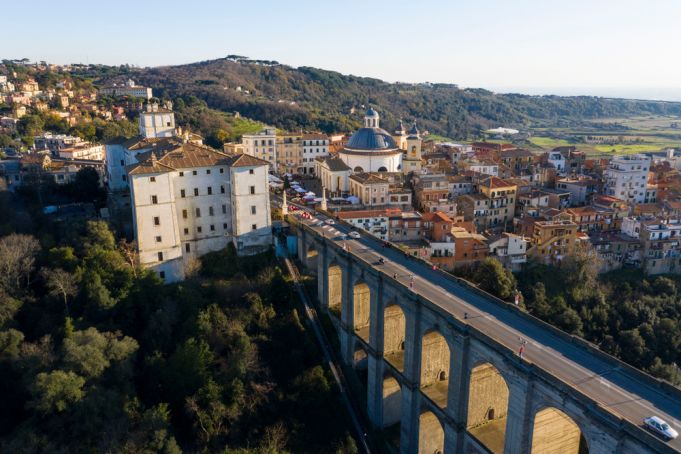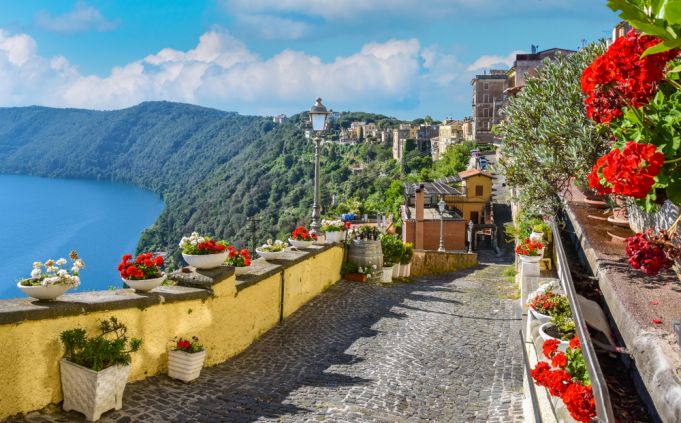Il Parco Regionale dei Castelli Romani (The Regional Park of Roman Castles), is a scenic region located just outside of metropolitan Rome.
The former stomping grounds of Roman elites, the area is known simply as the “Castelli Romani” for the many Roman villas scattered throughout the region’s small towns. Built atop a volcano crater, the Castelli Romani are nestled around the Colli Albani, Alban hills, and Lakes Albano and Nemi. There are more than a dozen small towns and villages in the region, each rich in nature, history, and tradition.
What are the Castelli Romani like?
In Roman times, the Castelli Romani region was attractive to nobility for its fresh climate, scenic beauty, and close proximity to Rome.
The Alban hills and deep volcanic-crater lakes provide the Castelli Romani towns with microclimates that are cooler and more temperate than central Rome’s.
Though most of the towns and villages of the Castelli Romani fall off the beaten tourist track, they are beloved by local Romans who take day trips to the region to drink fine wine and escape the Roman heat. In general, the Castelli Romani have a charming, rural atmosphere, characterized by rolling hills and cultivated farmland.
What are the Castelli Romani known for?

Ph: The medieval town of Ariccia
Frascati, located on the outskirts of the Castelli Romani region and close to the Ciampino Airport, is the most tourist-traversed town of the Castelli Romani. It is a hotspot for wine-loving tourists, as the village is home to numerous renowned wineries. Grown in traditional, family-owned vineyards, Frascati wine is stamped with the DOC seal of Italian quality and can be found in shops and restaurants across Italy.
Also read:
Frascati isn’t alone in its celebration of tradition and quality. The Castelli Romani region lies atop fertile volcanic soil, perfect for agriculture. Since Roman times, Castelli Romani farmland has been used for specialty fruit, vegetable, and wine production. Some of the best strawberries in Italy grow in Nemi, the village located around Lake Nemi.
Marino, the closest of the Castelli Romani towns to Rome, grows so many grapes that in autumn, some of its fountains spout wine instead of water.
Ariccia, located between Lake Albano and Lake Nemi, is a pig-farming town famous for its Porchetta, a type of seasoned, slow-cooked pork. Ariccia is also know for its art.
What is there to do in the Castelli Romani?

Ph: Scenic sight in Castel Gandolfo
For those wine-loving tourists, take a tour of the Minardi Frascati Winery in Frascati, a traditional winery started by the Minadri family in the 19th century.
The Minardi Frascati Winery offers cooking classes, horse-back riding lessons, tours of the grounds, and of course, wine tastings.
Monte Porzio Catone is a small but unabashedly wine-obsessed village near Frascati. It is known as the “City of Wine” by locals. In Monte Porzio, stop for an Aperitivo and sip top-notch wines while enjoying views of metropolitan Rome in the distance.
Monte Porzio also has its fair share of historical sites, including the Barco Borghese, a partially-intact Roman villa.
For visitors with an interest in food, every year in early summer, Nemi hosts a village-wide strawberry festival. The town transforms into a strawberry theme park, with strawberry decorations donning streets and piazzas, and street-side vendors selling every type of strawberry jam, pastry, and dessert you can imagine (not to mention fresh strawberries).
Genzano, located near Lake Nemi, has an annual June flower festival known as L'Infiorata, in which artistic flower arrangements cover the streets.
Marino’s grape festival takes place in October, for those who want to see the fountains of wine for themselves.
Tusculum, located near Frascati, is one of the most historically important villages among the Castelli Romani. Legend has it that Tusculum was founded by Uylsses’ son, Telegonus. Under the Roman Empire, it was one of the most prestigious sites in the area.
Figures such as Cicero, Tiberius, and Silla used the town as a holiday home. The Tusculum Amphitheater stands today as an impressive symbol of the area’s past. Private tours of the amphitheater can be taken with the Gruppo Archeologico Latino Vetus.
In Albano Laziale, the town that stretches around Lake Albano, ancient Roman baths, an amphitheater, and a cistern can be toured by the public. Explore the Museum of Villa Ferrajoli to get a glimpse of Albano’s historical timeline through archaeological artifacts.
Also read:
In Grottaferrata, the town next-door to Frascati, visitors can explore the Exarchic Monastery of Santa Maria di Grottaferrata, the last standing Byzantine-Greek monastery in Italy. It dates back to the year 1004.
Castel Gandolfo, one of the hilltop Castelli Romani towns, has been used as a vacation home for the Pope since the 1500s, providing a secluded refuge away from summer in the Vatican City.
In 2016, Pope Francis broke this tradition by opening the Palace of Castel Gandolfo, the Papal residence, to the public. Tourists can now explore the Palace of Castel Gandolfo as a museum and enjoy dazzling views of Lake Albano from its manicured gardens.
For tourists with a taste for the surreal, there is an anti-gravity hill in Ariccia. Located on Via Ariccia and known as the Saliscendi, the up-down, this is a naturally occurring phenomenon that creates an illusion of gravity operating in reverse. Ariccia is also an interesting architectural site, characterized by stark Baroque buildings.
How can I get to the Castelli Romani?
Trains from the Roma Termini station in Rome travel frequently to Frascati. Tourists who want to explore the Castelli Romani region can use Frascati as a starting point and travel from village to village using public transportation.
Also read:
- Steam train from Rome to Castel Gandolfo
Vatican train to Barberini Garden at Castel Gandolfo outside Rome
Trains from Roma Termini also run to Castel Gandolfo and Albano Laziale. Many tourists enjoy visiting the Castelli Romani by car, as the region is less than an hour drive away from Rome, and all of the towns in the region are close to each other.
Top ph: Aerial view of the town of Genzano
General Info
View on Map
Getting to know the Castelli Romani: A beginner's guide
Castelli Romani, Corso Vittoria Colonna, Marino, Metropolitan City of Rome, Italy





















